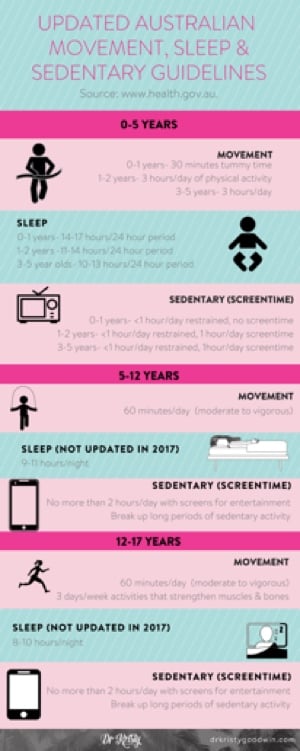The universal digital dilemma facing modern parents is ‘how much screen time is appropriate for my child?’ Nearly every parent wrestles with this question at one point.
Parents vary enormously in terms of how much time their children spend with digital devices. They range from complete digital abstinence – “My child doesn’t watch any TV, use an iPad or own a gaming console” right through to digital immersion- “My pre-schooler is learning how to code.”
The Australian government has developed screen time guidelines that suggest certain screen time limits for children of different chronological ages (summarised in the image below). These guidelines should be used as a rough estimate, a ballpark figure for healthy screen time limits and not as a prescriptive limit that we need to adhere to as parents.

It’s important to note that these time-based guidelines have never been scientifically-validated. These guidelines are based mainly on research with passive types of technology (TV and videos) and not more interactive types of technologies like touchscreen devices. These guidelines only address one part of the equation when it comes to kids and screens and healthy technology habits- ‘how much’.
Of course, parents and carers need to set and enforce screen time limits for their children (many kids would walk around with their digital appendage if we let them), but we need to consider more than simply how much time our kids are plugged in.
What Are Kids Doing With Screens?
Parents and carers also need to look at what kids are doing with screens (is it age-appropriate, leisure or learning?), when they’re using them (before school and sleep we need to make careful choices), how they’re using them (are they harming their vision or hearing?), where they’re using them (what places in the house are screens used?) and with whom they’re using screens (do you know who they’re interacting with online? When we consider all of these questions, we have a much more comprehensive picture of kids’ screen time habits and can determine if they’re healthy or harmful.
Why Setting Screen Time Limits Is So Hard
Parents must set firm boundaries around how much time kids can spend with screens. However, as a mum, I know that this is really difficult for parents to do. I understand how persistent kids can be when they plead desperately for just, “…ten more minutes on the iPad puh-lease.” One of the reasons that enforcing time limits with kids and screens is challenging is because in the online world kids enter the ‘state of insufficiency’ (we do too as adults). Kids rarely feel ‘finished’ or ‘done’ when using screens. There are always more levels in the game to reach, or another SMS that can be read or sent, or another TV episode vying for their attention.
Another reason kids find it hard to adhere to screen time limits is because they enter the ‘psychological state of flow’ when they’re on a device. They often become so engrossed with what they’re doing or watching online that they literally lose track of time. So when they say, “But I’ve only just started playing!” when in reality they’ve been gaming for two hours, they’re not trying to trick you. They’ve literally lost track of time.
A Simple (Realistic) Formula For Calculating Screen Time Limits
Our kids definitely need parents to help them use technology for healthy amounts of time, especially now that we understand why it’s so hard for them to manage their time online (state of insufficiency and flow).
I’ve found that using a simple formula, instead of trying to adhere to the government recommendations, is a much easier and a realistic way to develop healthy screen time limits for kids.
If we’re to imagine our child’s day, we need to make sure that their basic developmental needs are being met. Research consistently tells us that kids have basic developmental priorities for optimal health. We need to ensure that their developmental needs aren’t being displaced by screens. As parents we need to ensure that kids engaging in play, being physically active, developing their language and social skills, getting sufficient sleep and still being creative? Or is screen time interfering with these developmental priorities?
24 hours – sleep– physical activity – play – social interaction – language skills – nutrition = time available for screen-time
If kids’ basic needs are being met then we don’t have to fret about screen time harming their health and development. And this means we can finally ditch our guilt about kids’ screen time.
Dr Kristy Goodwin is a digital parenting educator, speaker, author of ‘Raising Your Child in a Digital World’ and mum to two boys (and yes, they do throw techno-tantrums). Kristy helps parents and professionals ditch their guilt and guesswork when it comes to raising young kids in a digital world, by arming parents with facts, not fears. Kristy’s digital home is www.drkristygoodwin.com
Share your comments below.
More From Kristy Goodwin
Three Important Things Parents Need to Consider Before Using Google Home





















-

-
-
meedee said
- 23 Jul 2022
Reply
Post a comment8:40 am
To post a review/comment please join us or login so we can allocate your points.